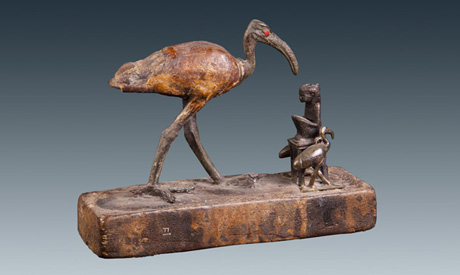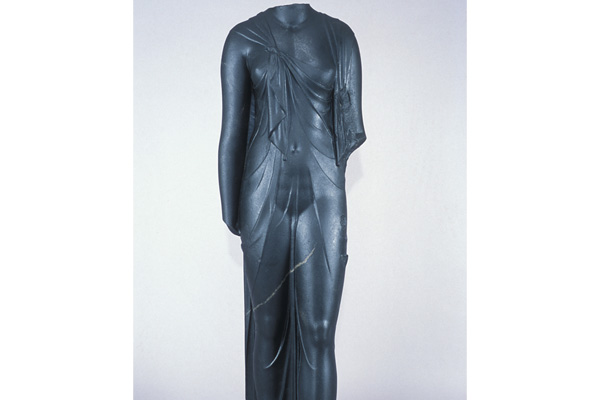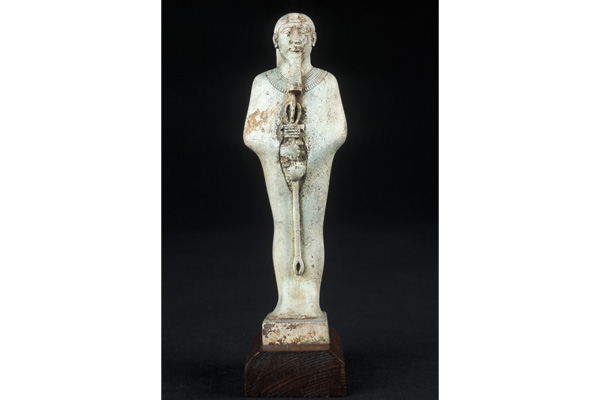http://english.ahram.org.eg/NewsContent/9/40/321141/Heritage/Ancient-Egypt/Masterpieces-of-the-Bibliotheca-Alexandrina-Antiqu.aspx
Egypt: Masterpieces of the Bibliotheca Alexandrina Antiquities Museum
The Bibliotheca Alexandrina Antiquities Museum houses one of the most important collections of ancient and Graeco-Roman antiquities in Egypt

Having roughly 1,000 to 1,200 pieces, it displays the enormous diversity of Egyptian cultural heritage through the ages. Walking among its treasures means going on a journey through five millennia.
The museum presents the long history of Egypt from ancient times to the Graeco-Roman period, through the Coptic period, to the Islamic period, and finally to the printing press that Napoleon Bonaparte brought to Egypt at the end of the 18th century.
This article presents some of my favourite pieces from the amazing collection of the Bibliotheca Alexandrina Antiquities Museum from ancient and Graeco-Roman Egypt.
Statuette of Imhotep (BAAM 591)
Imhotep was the most famous architect in ancient Egypt and the vizier of the owner of the Step Pyramid at Saqqara, king Djoser of the Third Dynasty. This bronze statuette shows Imhotep sitting with his hands resting on his knees holding a papyrus roll. Imhotep was honoured throughout ancient Egypt. As a result, he received many titles such as "high priest", "sage", "chief scribe", and "son of the god Ptah". Imhotep was later considered the god of wisdom, writing and medicine. The ancient Greeks associated him with their god of medicine Asclepius.

Ptah was the major deity of the ancient Egyptian capital Memphis. The ancient Egyptians believed that he created the world by thought and word. The statuette shows him as a man shrouded like a mummy. His hands, projecting through his shroud, are clasped around the kingship (was), stability (djed) and life (ankh) emblems. Ptah's shoulders are covered with a broad collar with a counterpoise hanging from the base of his neck.

This group represents Thoth as an ibis standing before Maat who is squatting on a chair flanked by two other small ibises. The upper part of the tripartite headdress of the goddess has a hole in which was probably fixed her symbol of an ostrich feather.
Box in the shape of a naos (BAAM 799)
This kind of box was typically varnished black. It was intended to keep the gilded images of deities. Many of these boxes were found in the tomb of Tutankhamun containing different images of deities. They were opened during ceremonies and then closed when carried or kept in tombs. The specimen here is well-manufactured and could have been part of the funerary equipment of a great king of the 18th Dynasty.
The uraeus-snake and blue crown or khepresh worn by this statue confirms the royal origins of the figure. The style and treatment of the snake, crown and face date it to the fourth century BCE.
This block statue of the priest Djed Khunsu Iouef Ankh shows him seated in a squatting position and holding symbols of power and wealth. He wears an incised wig. The statue was discovered in the Karnak Cache. Hieroglyphic inscriptions cover the statue with the names and titles of its owner and his ancestors, prayers and offerings to deities.
This is the wooden anthropoid coffin of a man called Iba, the son of Ankh Hor, ruler and treasurer of Upper Egypt. The coffin is fully decorated in the shape of a mummy resembling Osiris with an upturned ceremonial false beard and wig.
The eyes are inlaid with ivory and ebony. Iba wears a large multicoloured necklace, and the sky-goddess Nut appears on the chest area. The goddess Isis with her wings spread out is portrayed on the feet, while the goddess Nephtys appears on the head.
The three goddesses offer their protection to the deceased. The coffin lid is also decorated with texts from the ancient Egyptian Book of the Dead and the base shows hieroglyphic inscriptions.
Alexander the Great (356-323 BCE) was the conqueror of the ancient world. When he was 13, Alexander became a student of Aristotle and became interested in philosophy, medicine and science. He later conquered the Persian Empire. This head of Alexander the Great shows his conventional features. The eyes are looking up. The hair is curly and abundant, but indistinct from the back. Traces of red can be noticed. The nose is straight. Two cavities at the top of the head indicate that a crown or a decorative element used to surmount it.
Mosaic depicting a sitting dog (BAAM 859)
The ancient Greeks used mosaics to decorate floors in public places and private dwellings by using tesserae in different ways. This floor mosaic uses tesserae made of minute stone cubes ranging from one to four millimetres in size. The central medallion bears the picture of a dog, the first time such a motif has been found on a floor mosaic in Alexandria.
The dog is resting on his hind legs close to an upturned Greek vessel. The naturalistic image expresses strength and vitality, which points to the ability of the artist to use this medium to achieve clarity of design and definition.
The coat of the dog and its spots and red collar are executed very precisely. The main colours include black, white, and yellow, yet the artist is able to convey light and shade in a brilliant manner. The angle of the dog's portrait shows it turned three-quarters from the viewer, and the front part reflects light, while the rest of the body is in the shade.
The gradation of the shading on the upturned bronze pot shows light reflected on the central part, while the sides are darker.
The ancient artist has indeed been able to express great depth in a "hard" medium, and this mosaic is a testament to the sophistication of mosaic workshops and artistry in ancient Alexandria. Perhaps the theme of this floor is a scene from a theatre play or from a literary work of art from Alexandria during the first three centuries BCE.

Head of Ptolemy III Euergetes ("The Beneficent"), the oldest son of Ptolemy II and his wife Arsinoë I. Ptolemy III succeeded his father to the throne of Egypt in January 246 BCE.
Head of Queen Berenice II (BAAM 2)
Berenice II, "The Benefactress", a queen of Egypt, was the wife of Ptolemy III Euergetes, who married her on his accession in 246 BCE. She ruled Egypt during the war led by her husband against the Syrian king Antiochus III. The poet Callimachus extolled her beauty and wrote her praise in a poem named "The Lock of Berenice".
This head of Queen Berenice II has Hellenistic features such as protruding eyes that gaze directly forward and a face with a grave expression. The hair is styled in the form of a diadem surrounding her head. The legend says that Berenice, hoping for her husband's safe return from his campaigns, cut off a lock of her hair and dedicated it to the Temple of Aphrodite.
This lock later disappeared from the temple and was said to have become a star that bore the name of the queen. The poem by Callimachus tells this legendary story with much honour done to the queen.
This statue of a Ptolemaic queen is probably of the Ptolemaic queen Arsinoë II, the wife of Ptolemy II. It must have been slightly larger than life-size. On the right breast, as on numerous other statues of Ptolemaic rulers, there is a knot that joins the ends of the shawl the woman wears. Scholars frequently refer to this knot as the "Isis knot." The dress provides more clues about the identity of the subject: the handling of the fabric recalls the marble work of Hellenistic artists showing Aphrodite in "wet drapery". The folds undress the figure more than they dress it.
This statuette is from the Tanagra Collection. Tanagra was the name of the city in which a large number of these statuettes was found, and they are made of burnt clay with colours depicting clothes, hairstyles, and facial features. This kind of statuette appeared in Alexandria in large quantities from the fourth until the second century BCE. This painted terracotta statuette represents a schoolgirl sitting on a chair and copying out her lessons on a wax tablet on her lap.
his bust is a Roman replica depicting the ancient Greek philosopher Socrates. The head is set on a shaft, and the figure has stump-like arms. It is a Roman replica of a Greek original, and it dates to the fourth century BCE. The Roman influence is obvious in the realistic features, as well as in the hairstyle and the beard, while the Greek influence appears in the rounded face and the meditating look that has a touch of perfectionism.
Many portraits of infant boys appear to have had hairstyles resembling that of the Emperor Trajan (98-117 CE). This marble statue portrays a sleeping boy sitting on a rock. He is wearing a Roman tunic and has a conical head cover. His sandals are finely carved. A similar statue is displayed in the National Museum in Rome, where the boy is holding a lantern in his right hand. However, the lantern here is missing. This statue was found in 1997 by a fisherman in Lake Borollos in Kafr Al-Sheikh.
I hope you have enjoyed this small tour of items from the collection of the Bibliotheca Alexandrina Antiquities Museum from ancient and Graeco-Roman Egypt. I also hope that one day you will be able to visit the Library of Alexandria and its museums, especially the Antiquities Museum.
The writer is director of the Bibliotheca Alexandrina Antiquities Museum.
*A version of this article appears in print in the January 3, 2019 edition of Al-Ahram Weekly under the headline: Masterpieces of the Bibliotheca Alexandrina Museum
-- Sent from my Linux system.
No comments:
Post a Comment